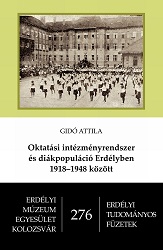Oktatási intézményrendszer és diákpopuláció Erdélyben 1918–1948 között
Educational Institutions and Schoolage Populati on in Transylvania between 1919 and 1948
Author(s): Attila Gidó
Subject(s): History, Social Sciences, Education, Ethnohistory, Social history, Interwar Period (1920 - 1939), WW II and following years (1940 - 1949)
Published by: Erdélyi Múzeum-Egyesület
Keywords: educational institutions; Transylvania; XXth Century; the period between the two world wars; statistics ofstudents
Summary/Abstract: Our analysis presents the changes in the Transylvanian educational institutions and in the number of their students, according to levels of education, school types and the maintainers of the schools. The available statistics are incomplete and this did not allow us to make an exhaustive and complete presentation of the development of public education in the region. Nevertheless, we can more or less reconstruct the main characteristics of the education market and of the institutions of the educational system between 1918 and 1948 based on the data presented in our paper.On the territories annexed to Romania after World War I, and especially in the parts gained from Hungary, state schools were established in a higher rate than the national average, either through the nationalisation of institutions of Hungarian language or through the construction of new schools. The large-scale developments in infrastructure had two reasons. The first reason was to consolidate the position of the Romanian population living in the newly acquired territories as opposed to Hungarians and Germans and to the denominational schools run by minorities.The other reason was the changed role of the state in the public education. Prior to 1918 in Transylvania, in line with the practice of Hungary, educational institutions were primarily maintained by denominations, while in Romania the role of the denominations was insignificant in this respect. Thus, the Romanian state basically aimed at implementing its existing school policy also on the newly acquired territories.All these resulted in the fact that while in the 1920/1921 school year only 32.7% of the primary schools were functioning in Transylvania were maintained by the state or by the communities, by 1928/1929 this proportion jumped to 77.8%.This switch in proportion can also be observed in case of lyceums and upper girls’schools, although to a smaller degree.The data on Romanian students already indicate the effects of school policy of the Romanian Government. Prior to 1918 in Romania – thanks to the reforms of public education minister Spiru Haret –heavy emphasis was placed on practical education. This approach made its way to Transylvania, and resulted in the increased proportion of Romanian students in trade, vocational and housekeeping schools which exceeded by far the proportion of the minorities. Further factors also contributed to this: vocational schools were maintained by the state and the language of instruction in these schools was Romanian. The fact that these types of institutions were accessible for the Romanian population living mainly in rural areas is not incidental either.The proportion of Romanian students was dominant also in teacher training schools, which ensured the supply of pedagogues who were meant to fulfill the need for teachers of the expanded primary school system. Commercial schools and lyceums were also maintained primarily by the state, and this was also visible in the proportion of Romanian students. Consequently, these institutions not only ensured the closing-up of the educational gap between the Romanian population and the minorities but also established the basis of the ethnic elite change (Romanians were employed in state offices, cultural apparatus, and as professional intelligentsia).Higher education essentially mirrored the situation of secondary schools. In the case of Romanians and Jews we can again observe the overschooling, with the notable difference that in the case of Jewish students there was a decreasing tendency while in the case of Romanian students there was a continuous increase. In the period between the two world wars the supply for new generations of intelligentsia for the minorities slowed down and did not meet the societal demands.On the other hand, the number of Romanian graduates increased as a result of the “Romanianisation” of secondary schools with Matura and increased the numberof students enrolled in universities.The evolution of the Transylvanian educational system and that of the educational market were defined all along by the state policies (the elite formation strategies and the ethnic policies).
- Print-ISBN-13: 978-606-8178-75-2
- Page Count: 210
- Publication Year: 2013
- Language: Hungarian
- eBook-PDF
- Table of Content
- Introduction

